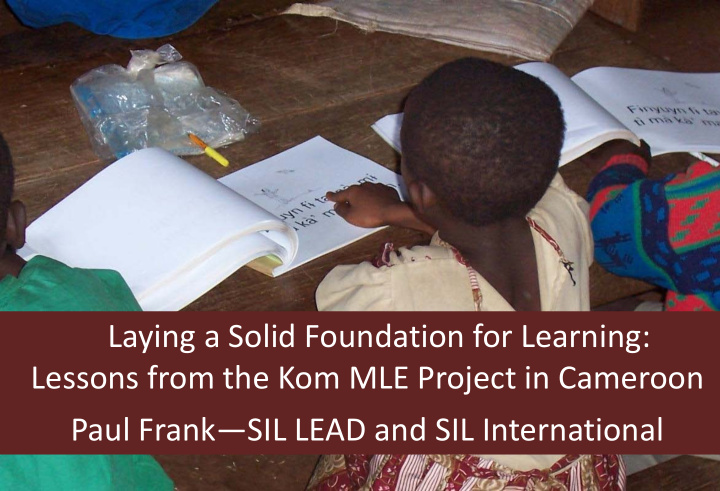



Laying a Solid Foundation for Learning: Lessons from the Kom MLE Project in Cameroon Paul Frank—SIL LEAD and SIL International
What is “MLE”? • Mother tongue-based multilingual education (MTB- MLE or just MLE) • Using the child’s mother tongue as the initial language of instruction • Introducing an additional language or languages subsequently, first in oral form, and later in written form • “Mother tongue”, “Home language”, “First language”, “A language the child understands well”
Why use an MLE approach? • Children can learn if they understand • Easier to teach reading when the child knows the language • Greater educational success • True even for the second language
Why isn’t MLE used more often? • Official language more valuable? • Move to the new language quickly • Using first language waste of time or hindrance?
Kom Education Pilot Project (KEPP) • English-speaking North West Region of Cameroon • Approximately 250,000 speakers • Kom is primary language in the area • School staff speak Kom • English is primary language of instruction • Performance very poor
What was the intervention? • Grades 1-3: Kom is language of instruction • Students also learn oral English • Third grade: learn to read and write in English • Fourth grade: transition to English
Baseline • Reading comprehension in English: – 4% after one year of school – only 20% in Class 6 • Math scores: – under 10% – even counting under 15% • Some children in Class 4 “had never held a pencil or written on a piece of paper”
One year—comparison of scores Histogram of Overall Performance - Grade 1 25 Program English KEPP 20 Mean StDev N 18.36 13.13 335 Percent of Students 59.57 25.04 323 15 10 5 0 0 20 40 60 80 100 120 Scores (Percent)
Comparison on sub-tests 70 English-medium 60 Kom-medium Average Score (Percentage) 50 40 30 20 10 0 Reading Math Oral English Test Components
Comparison on reading sub-tests 80 English-medium 70 Kom-medium Average Score (Percentage) 60 50 40 30 20 10 0 Word identification Grammar Reading Overall comprehension Test Components
Specific features of the intervention • Children learn to read in Kom • Reading out loud to students • Phonics to teach decoding • Integrated reading curriculum • Questioning strategies to promote comprehension and reasoning
And there’s more! • 10 minutes daily for independent reading or writing • English language development • Instruction in math • Teacher training • Teacher support
Results after five years
Conclusions after five years • Use of mother tongue has brought significant improvements • Gains of more than 60% • Stronger reading comprehension, oral proficiency, knowledge of English
The difficulties of early exit programs • “Early exit”: complete transition to another language early in primary school • “Late exit”: use the mother tongue throughout primary • Late exit programs have stronger outcomes • Kom project shows weaker outcomes
In their own words…
Questions? Comments?
Credits • Dr. Stephen L. Walter, Professor Graduate Institute of Applied Linguistics, Dallas, Texas USA • Dr. Kristine Tramell, International Consulant in Literacy and Education, SIL International • Kain Godfrey Chuo, Literacy Specialist, SIL Cameroon
Recommend
More recommend